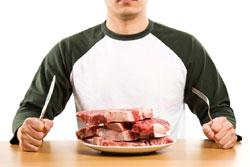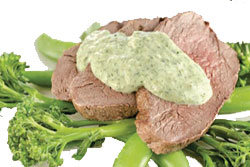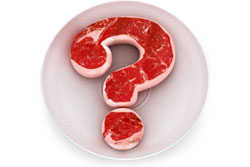Nutritional value of meat
- Health and nutritional benefits of meat
- Dietary recommendations of meat consumption
- Healthy eating tips
Introduction to meat and meat products
Meat and meat products are rich and concentrated sources of nutrients including fats, proteins, vitamin B12, zinc and iron.
Meat is categorised into red meat and white meat. Meat from any source is of similar nutritional value, whether it is white or red. The intensity of colour in meat depends on the amount of myoglobin it contains. It is incorrect to assume that white meat from birds is superior to red meat, or vice versa. Offal meat (i.e. internal organs such as liver and kidney), however, tends to have a higher nutritional value, and red meat is known to contain a rich source of iron.
The distinguishing element among the various sources of meat appears to be the fat content. Some scientists consider red meat (e.g. beef, lamb and goat) to be less healthy because it has a relatively higher fat content compared to white meat. Saturated fat in meat may predispose people to cardiovascular disease.
There are many reasons for people to eliminate meat and meat products from their diet. Some of these reasons may include health concerns, religion, cultural background, income and accessibility of meat.
Red meat
Red or dark meat is mainly made up of muscles with slow fibres. These muscles are used for extended periods of activity, such as standing or walking, and need a steady energy source. Red meat refers to the muscle meat from cattle, sheep, goat and kangaroo and essentially provides considerable amounts of zinc and vitamin B12.
The pigment that is primarily responsible for the red colour of meat is myoglobin, a protein that can bind and store oxygen in cells. The amount of myoglobin in meat varies according to species, age of animal, amount of exercise, stress, condition of storage, exposure to oxygen, heat and processing.
Tissues and organs that require more oxygen for their functions have more myoglobin, and therefore are redder in colour. Beef is shown to contain more myoglobin in its tissue than lamb.
Myoglobin levels also vary depending on muscle use. More active parts of an animal require more oxygen and will therefore have more myoglobin and consequently, be redder or darker in colour. For example, chicken legs are darker than chicken breasts because their legs are more active.
White meat
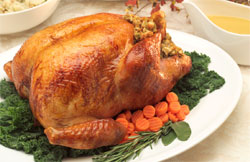
Myoglobin content is low in white meat. This explains why chicken breast and veal are slightly pink or white. The colour of fish meat is white because it lives in water and does not need to support its own body weight, and therefore has no myoglobin in its muscles.
Nutritional value of meat
Protein is the fundamental structural and functional element within every cell, and is made up of 20 common amino acids. There are eight amino acids which are not produced in the body and must be supplied by food. These are classified as essential amino acids.
The majority of the foods we eat contribute some amounts of protein to our diet. Animal products have a higher protein content than fruits, vegetables and breads. Muscle meat is a good source of protein. Meat is rich in essential amino acids, particularly sulphur amino acids.White meat contains an equivalent amount of protein to red meat.
Protein from meats, fish and poultry are more easily digested than protein from beans and wholewheat.
Fat is distributed throughout meat. The fat content of meat varies depending on animal breed, age, amount of exercise and diet. Lean red meat provides 2-5g of fat per 100g of dietary fat. It has almost equal amounts of saturated and monounsaturated fats, and a small amount of polyunsaturated fat.
Skinless chicken have the same fat content as lean red meat. There is more monounsaturated fat and polyunsaturated fat in skinless chicken compared to other meats.
The fat content of meat varies as follows:
- Red meat: beef (3.5-9.3 %), lamb (7.5-13.3%)
- White meat: Chicken (1.1-9.7 %), turkey (2.0-6.6 %)
- Processed meat: Burgers and sausages have the highest fat content (up to 25%)
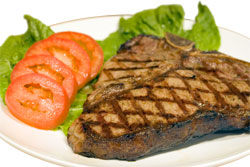
Red meat (e.g. beef and lamb) is the best source of iron. Chicken contains moderate amounts of iron, while fish has the least amount.
Iron deficiency is progressive. Anaemia develops at its final stage. When iron stores in the body are depleted, the amount of iron circulating in the blood is decreased, causing a fall in red blood cell production. Mild iron-deficiency anaemia leads to reduced work capacity, slower response to exercise, impaired immune function, and changes in mood and cognitive performance. In children, iron-deficiency anaemia is associated with psychomotor development. In pregnancy, iron-deficiency anaemia causes prematurity, low birth weight and increased perinatal mortality.
Zinc is a trace mineral that can be found in almost every cell in the body. Zinc is essential to the human body because it stimulates enzyme activities, provides a healthy immune system, is used for wound healing, sustains senses of smell and taste, and is used for DNA synthesis. Zinc is also important for normal growth and development during pregnancy, childhood and adolescence.
Meat is a major source of readily available zinc. The liver and kidney are richer sources than muscle meat, and pig liver is richer in zinc than sheep or beef liver. Zinc from animal sources (including eggs) is better absorbed than zinc from plant foods (e.g. wholemeal bread).
Vitamin B1 (thiamin) occurs naturally in duck, oyster, and other meats. A deficiency of vitamin B1 can cause beri-beri and Wernicke-Korsakoff syndrome, which result in neurological and cardiovascular dysfunction. These two syndromes are normally seen in alcoholics, and seldom seen in vegans. Vegans can derive their vitamin B1 from plant sources (e.g. nuts, pulses, oatmeal, fortified breakfast cereals, etc).
Offal is the best source of vitamin B2 (riboflavin). Riboflavin aids the metabolism of carbohydrates, fats, and proteins. It plays an important role in reproduction, and in the growth and repair of joints, skin, hair, and nails. It also enhances the immune system’s ability to fight disease.
Vitamin B3 (niacin) is found in foods that are high in protein (e.g. liver, kidney, poultry and fish). Vitamin B3 helps to remove toxic and harmful chemicals from the body. It helps produce various sex and stress-related hormones in the body. Vitamin B3 helps improve circulation and reduce blood cholesterol levels.
Vitamin B12 (Cobalamin) is necessary for cell division and blood formation.Vitamin B12 is synthesised by microorganisms and is found in bacterially fermented foods, meat, and offal from ruminant animals.Offal, particularly liver, contains more vitamin B12 as this is where the vitamin is stored. Occasionally, cobalamin is found in soil and water because they are contaminated with microbes that produce vitamin B12. This is how plants derive an inactive form of this vitamin.Shellfish, fish and meat are also rich in vitamin B12.
Health and nutritional benefits of meat
A study conducted in Perth, Australia showed that the per capita consumption of red meat had fallen steadily, while white meat consumption rose. One of the factors that contributed to this pattern was rising concerns about fat, cholesterol, nutritional value, calories, fibre, waste and artificial additives. Lean meat is rapidly becoming the preferred choice, but it is often more expensive.
Meat definitely has great nutritional value but consumers must be reminded that too much of a good thing can be harmful. Human population studies show that red and processed meats are associated with an increased risk of colorectal cancer, but white meat is not. The evidence is not yet conclusive, but consuming a lot of preserved meat probably increases the risk of colorectal cancer.
Scientific studies have demonstrated that the key factor in disease outcomes is the dietary patterns rather than the individual food components. Dietary patterns that mainly contain processed meats are more associated with some diseases including CVD, colon cancer and type II diabetes, than dietary patterns that mainly contain poultry.
Dietary recommendations of meat consumption
The NHMRC Dietary Guidelines for Australians on meat consumption are:
- Males aged 19-60 years: 1 serve of lean meat, fish, poultry, nuts and legumes each day
- Females aged 19-60 years: 1 serve of lean meat, fish, poultry, nuts and legumes each day
- Pregnant women: 1 ½ serves of lean meat, fish, poultry, nuts and legumes each day
- Lactating women: 2 serves of lean meat, fish, poultry, nuts and legumes each day
Note: A sample serve is 65-100 grams of cooked meat or chicken (e.g. ½ cup mince, 2 small chops, or 2 slices of roast meat) or 80-120 grams of cooked fish fillet.
The NHMRC Dietary Guidelines for Australians recommends that lean red meat be consumed 3-4 times a week, and fish 1-2 meals per week.
Individuals that have high iron needs (e.g. girls, women, vegetarians and athletes) might require high-iron replacement foods.
Healthy eating tips
- Enjoy lean red meat 3-4 times each week.
- Choose lean meat, or trim the fat off your meat.
- Eat less sausages and processed meats.
- Try to eat 1-2 fish meals a week.
Meat recipes
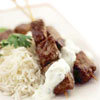 |
Healthy recipes featuring meat, ranging from light lunches to evening meals. |
For more information, see Meat Recipes.
More information
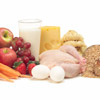 |
For more information on food groups and components, see Types and Composition of Food. |
 |
For more information on nutrition, including information on nutrition and people, conditions related to nutrition, and diets and recipes, as well as some useful videos and tools, see Nutrition. |
References
- Australian Meat & Live-Stock Corporation. Consumer attitudes towards meat. 1994.
- Chan W, Brown J, Lee SM, Buss DH. Meat, Poultry and Game. Fifth supplement to McCance and Widdowson’s The Composition of Foods. London: Royal Society of Chemistry and Ministry of Agriculture, Fisheries and Food, HMSO; 1995.
- Cummings J, Bingham S. Diet and the prevention of cancer: Clinical review. British Medical Journal 1998; 317: 1636-40.
- Freeland-Graves JH, Peckham GC. Foundations of food preparation, Upper Saddle River, New Jersey, United States of America; 1995.
- Fung TT, Hu FB, Fuchs C, et al. Major dietary patterns and the risk of colorectal cancer in women. Arch Intern Med 2003;163: 309-14.
- Hill M. Meat, cancer and dietary advice to the public. European Journal of Clinical Nutrition 2002; 57: S36-41.
- Hu FB, Rimm EB, Stampfer MJ, Ascherio A, Spiegelman D, Willett WC. Prospective study of major dietary patterns and risk of coronary heart disease in men. Am J Clin Nutr 2000; 72: 912-21.
- Kontogianni MD, Panagiotakos DB, Pitsavos C, Chrysohoou C, Stefanadis C. Relationship between meat intake and the development of acute coronary syndromes: the CARDIO2000 case-control study. Eur J Clin Nutr 2007.
- Mann J, Truswell AS, editor. Essentials of human nutrition. 3rd ed. New York: Oxford University Press; 2007.
- National Health and Medical Research Council. Dietary Guidelines for Australian Adults. Commonwealth of Australia; 2003.
- Norat T, Lukanova A, Ferrari P, et al. Meat consumption and colorectal cancer risk: A dose-response meta-analysis of epidemiological studies. International Journal of Cancer 2002; 98: 241-56.
- Pryer JA, Nichols R, Elliott P, Thakrar B, Brunner E, Marmot M. Dietary patterns among a national random sample of British adults. J Epidemiol Community Health 2001; 55: 29-37.
- Quatromoni PA, Copenhafer DL, D’agostino RB, Millen BE. Dietary patterns predict the development of overweight in women: The Framingham Nutrition Studies. J Am Diet Assoc 2002; 102: 1239-46.
- Tode S, Bird AR, Topping DL, Conlon MA. High red meat diets induce greater numbers of colonic DNA double-strand breaks than white meat in rats: attenuation by high amylose maize starch. Adelaide, Australia: Carcinogenesis [online] 2007 [cited 2008 March 9]. Available from URL: www.foodscience.csiro.au/records.htm 2007.
- Storer C. Research on the Consumer Lamb Meat Market in Perth. Western Australian Farmers Federation Annual Conference, Perth; 1994.
- Storer CE, Soutar GN, Hawkins MH. Meat consumption patterns of meat consumption: some Australian evidence. Agribusiness Review 1998; 6.
- Van Dam RM, Gievink L, Ocke MC, Feskens EJ. Patterns of food consumption and risk factors for cardiovascular disease in the general Dutch population. Am J Clin Nutr 2003; 77: 1156-63.
- Van Dam RM, Rimm EB, Willett WC, Stampfer MJ, Hu FB. Dietary patterns and risk for type 2 diabetes mellitus in US men. Ann Intern Med 2002; 136: 201-9.
- WHO/FAO. Nutrition and the Prevention of Chronic Disease. WHO Technical Report Series 916. Geneva: WHO/FAO; 2003.
All content and media on the HealthEngine Blog is created and published online for informational purposes only. It is not intended to be a substitute for professional medical advice and should not be relied on as health or personal advice. Always seek the guidance of your doctor or other qualified health professional with any questions you may have regarding your health or a medical condition. Never disregard the advice of a medical professional, or delay in seeking it because of something you have read on this Website. If you think you may have a medical emergency, call your doctor, go to the nearest hospital emergency department, or call the emergency services immediately.

